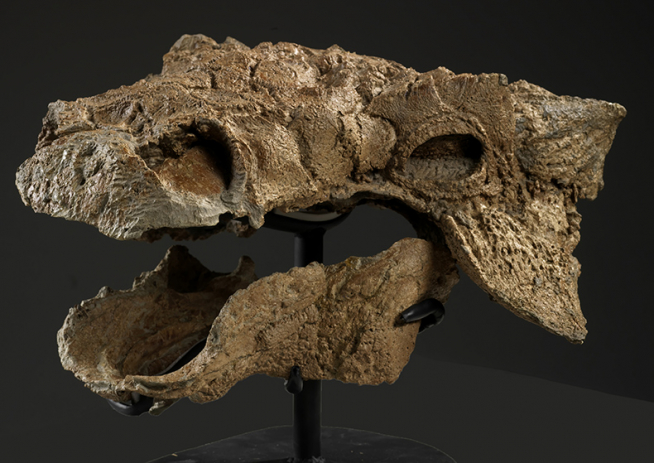Introducing Zuul, Destroyer of Shins, Generator of Science

Today, the ROM unveiled a new species of armored dinosaur, Zuul crurivastator, based on an almost complete and remarkably well-preserved skeleton from the Judith River Formation of Montana. The skeleton of Zuul was acquired by the ROM with the generous support of the Louise Hawley Stone Trust, and it represents a landmark addition to our collection of dinosaurs from western North America. It also marks the beginning of a big scientific project here at the museum. The name Zuul is based on similarities between the beautifully preserved skull of our fossil and the terror-dog monster from the 1984 blockbuster film Ghostbusters - both have a broad, rounded snout, gnarly forehead, and two sets of horns behind the eyes. The species name, crurivastator, translates to “Destroyer of Shins”, in reference to its menacing tail, which ends in a massive club-which may have been used to defend itself from predatory dinosaurs or compete with other members of its species.
Zuul is characterized by features of its heavily armored skull, and the armour forming its spiked tail. The research describing the new skeleton, identifying Zuul as a new species, and placing it in the family tree of armored dinosaurs was described in the journal Royal Society Open Science, and is open access- meaning it is free for everyone to download and read. The paper was led by Dr. Victoria Arbour, a globally recognized expert on ankylosaurs, who recently joined the ROM Palaeo team on an NSERC postdoctal fellowship. It was a fantastic experience working with Victoria on the paper - who also deserves big credit for coming up with the awesome name for our new dino. We have both really enjoyed working with our amazing palaeo-artist Danielle Dufault, who created the vivid life reconstructions of Zuul for the website, well as the whole behinds-the-scenes Zuul team.

Learn more about Zuul here.
A few quick highlights- what makes Zuul so exciting is its completeness. It is the only tail-clubbed ankylosaur skeleton known to include both a complete skull and a complete tail club. Ankylosaurs are rare dinosaurs, as they only form about 5% of the dinosaur assemblages they occur in, so the almost complete skeleton of Zuul is a key specimen for understanding the evolution and diversity of this group. The quality of preservation is exceptional, and includes soft tissues that do not normally fossilize. Of particular note are the horny coverings on the spikes at the base of the tail and the skin are present.

The research announced today is just the first phase of a larger project focusing on Zuul and its world. The soft tissues are particularly exciting, and we will be conducting research testing for the preservation of biomolecules. More exceptionally preserved skin is surely on the way. Zuul’s torso, which was connected to the tail block with the scales and horny sheaths on the spikes, is preserved in a massive, 15 ton, plaster encased block. This is will take years of careful work to uncover, but the process is underway by technician Robin Sissons at Research Casting International (the block was too big and heavy to fit in the ROM!). Robin will be sending periodic updates on prep progress, so check back in for more.
In addition, the 75 million year old river channel deposit that produced Zuul’s skeleton also produced a wide range of well-preserved fossils of other plants and animals living alongside Zuul. These fossils include complete turtles, a crocodile, bones of duck-billed dinosaurs, ostrich dinosaurs, and horned dinosaurs, plus plants, clams, snails and more. We are also conducting research reconstructing Zuul’s palaeoenvironment with geologist Federico Fanti, as well as precisely dating the age of the fossil deposit based on volcanic ash deposits with colleagues from the University of Toronto.

For me, one fundamental aspect of Zuul’s importance is its context. I’ve visited the quarry site several times, and the rocks are very familiar to me. The rock strata where Zuul was collected are also extensively exposed in southern Alberta, about 50 km to the north, where they are called the Oldman Formation. These rocks have been the focus of a long-term collaborative ROM field project, the Southern Alberta Dinosaur Project, where we have systematically collected thousands of specimens with carefully recorded temporal and environmental context. We can therefore place Zuul and its associated fossils precisely within this framework. In fact, our team is currently digging up a tyrannosaur and a duckbilled dinosaur from the same stream channel complex expressed in Alberta. Within this much bigger scientific dataset, Zuul contributes to a much larger understanding of how dinosaur diversity and evolution are related to environmental changes leading up the end-Cretaceous extinction event, which occurred less than 10 million years after Zuul lived.
The ROM is very excited about Zuul, and there is much more to come. If you want to see Zuul for yourself, we have big plans. We have a dedicated team working in programs, education, and exhibitions to showcase this amazing fossil. We are in the process of planning an exhibit, but in the meantime, you can see fossils of Zuul at ROM programs, including Friday Night Live Dino Night in early June. Stay tuned for more details:
More about Zuul
Read the Open Access paper
Learn more about Zuul on the ROM website
Follow Dr. Victoria Arbour (@VictoriaArbour) and see her blog
Read the Press Release
Join the Conversation: #DinoZuul @ROMToronto, @ROMPalaeo, @DavidEvans_ROM @VictoriaArbour
